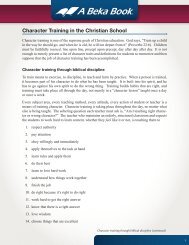Science & Health - A Beka Book
Science & Health - A Beka Book
Science & Health - A Beka Book
Create successful ePaper yourself
Turn your PDF publications into a flip-book with our unique Google optimized e-Paper software.
Biology cont.<br />
Human Anatomy & Physiology cont.<br />
• Nutrition and digestion:<br />
• Carbohydrates, proteins, lipids:<br />
h Incomplete proteins<br />
• Vitamins, minerals and water: importance, function, results of<br />
deficiencies:<br />
h Coenzymes<br />
h Scurvy, pellagra, pernicious anemia, xerophthalmia<br />
h Intracellular vs. extracellular fluid<br />
h Edema<br />
• Nutritional and caloric intake:<br />
• Breads and grains, vegetables, fruits, milk, meats and beans<br />
• Limiting fats, sugars and salts<br />
• Calories, metabolism<br />
h Obesity<br />
• Beginning of the digestive system:<br />
• Alimentary canal, digestion, enzymes, glands<br />
• Oral cavity:<br />
h Palate, bolus, papillae<br />
h Wisdom tooth, impacted, mastication<br />
• Esophagus: peristalsis, epiglottis<br />
• Stomach and intestines:<br />
• Stomach structure and function:<br />
h Hunger contractions<br />
• Gastric juice, hydrochloric acid, chyme<br />
h Intrinsic factor<br />
h Cardiac and pyloric sphincter<br />
• The liver and pancreas in digestion:<br />
• Bile, gallbladder<br />
h Bile salts, emulsification, common bile duct<br />
• Pancreatic juice<br />
h Sodium bicarbonate production by the pancreas<br />
• Small intestine:<br />
• Primary organ of digestion and absorption<br />
• Divisions of the small intestine<br />
• Villi<br />
h Microvilli, lacteal<br />
• Insulin, glucagon<br />
h Urea<br />
• Colon: function and structures<br />
• Gastrointestinal disorders:<br />
• Food poisoning<br />
h Dyspepsia<br />
• Ulcers, effects of alcohol<br />
h Constipation, diarrhea<br />
• Dysentery, colon cancer<br />
• Circulation and respiration:<br />
• Blood: cardiovascular system, arteries, veins, capillaries<br />
• Composition of blood:<br />
• Plasma, red blood cells, white blood cells, platelets:<br />
h Plasma proteins, circulatory shock<br />
h Red blood cell production, leukemia<br />
h Blood types: antigens or agglutinogens, universal donors and<br />
recipients, Rh factor<br />
<strong>Science</strong><br />
176<br />
• Design of the heart:<br />
• Structure:<br />
h Layers, valves, and skeleton<br />
• Blood flow:<br />
• Through the heart<br />
h To the heart<br />
h red indicates NeW MATerIAL<br />
h Types, symptoms, and treatment of heart failure<br />
h Heart beats, detailed structure and function of cardiac muscle,<br />
electrical system<br />
• Circulation of blood:<br />
• Arteries, veins, and capillaries:<br />
h Structure of blood vessels<br />
h Details of systemic circulation<br />
• Pulmonary circulation<br />
h Portal and renal circulations<br />
• Atherosclerosis<br />
• Blood pressure and pulse<br />
• Cardiovascular health: leading cause of death, treatment<br />
• Anatomy and function of respiratory system:<br />
h Types of respiration: external, internal, and cellular<br />
• Organs of respiration:<br />
h Nasal meatuses<br />
• Throat structures<br />
• Trachea, bronchi<br />
• Lungs:<br />
• Bronchitis, pneumonia, bronchial asthma<br />
• Pleural membrane:<br />
h Pleurisy<br />
• Diaphragm<br />
• The breathing process:<br />
h Role of intercostal muscles<br />
h Control by the medulla oblongata<br />
• Lung capacity:<br />
• Vital capacity<br />
h Tidal volume<br />
• Respiratory diseases:<br />
• Common cold, influenza, tuberculosis, emphysema, lung cancer<br />
h Cystic fibrosis<br />
• Integumentary, excretory, and endocrine systems:<br />
h Introduction: body’s design for maintaining homeostasis<br />
• Integumentary system:<br />
• Purpose<br />
• Structure:<br />
h Psoriasis, keratin in skin, skin pigments<br />
• Tanning, sunburn<br />
h Hair structure<br />
• Sebaceous glands<br />
h Details of sweat glands<br />
• Excretory system:<br />
• Kidneys:<br />
h Function, regulation, structures, failure, dialysis<br />
• Endocrine system:<br />
h Endocrine vs. exocrine glands<br />
• Hormones:<br />
h Hormone receptors<br />
Grade 10<br />
Biology cont. p. 177

















